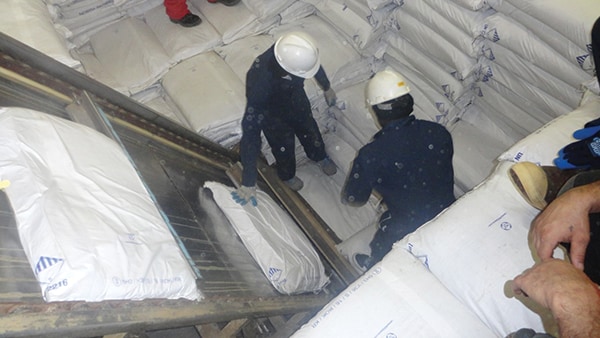Key points
Research shows that ergonomic hazards are a leading cause of injury and illness for seafood processing workers worldwide. NIOSH has an Elements of Ergonomics Program that can provide step-by-step guidance to evaluate and address ergonomic concerns in your workplace.

What is the health and safety problem?
Ergonomics is the science of designing jobs to fit workers, rather than forcing workers to fit their jobs. It involves creating tasks, equipment, tools, and work environments to accommodate workers' capabilities.
Exposure to ergonomic risk factors can damage workers' bodies, leading to musculoskeletal injury and illness. In the food manufacturing industries, including seafood processing, risk factors include:
- Repeating the same motion throughout the workday
- Working in awkward or stationary positions
- Lifting, pushing, and pulling heavy or awkwardly sized and shaped items
- Using excessive force to perform tasks, including using dull knives
- Working in cold temperatures
- Working long work hours
- Receiving inadequate recovery time, due to long shifts
Engineering interventions and solutions that incorporate Prevention through Design are better at addressing ergonomic hazards, and preventing musculoskeletal injuries and illnesses, than administrative controls (rotating work tasks, allowing rest breaks) and personal protective equipment.
What is the extent of the problem?
Around the world, research has found that ergonomic hazards are a leading cause of injury and illness for seafood processors.
NIOSH researchers recently analyzed injury and illness data among offshore and onshore seafood processors in Alaska. During 2010-2015, the traumatic injuries most commonly reported to the US Coast Guard among offshore seafood processors were sprains, strains, and tears (25%). Similarly, during 2014-2015, 40% of workers' compensation claims among onshore seafood processors were for musculoskeletal injuries and illnesses. Interviews with safety and health managers in Alaska's seafood processing industry have identified both successes and challenges for addressing complex ergonomic hazards.
What are recommendations for addressing ergonomic hazards?
How to fit the workplace to the worker12345
- Adjust workstations and standing surfaces to fit worker height and angle of tasks
- Arrange workstations, so any lifting is done in front of workers, without twisting
- Use mechanical devices that tilt or invert containers
- Perform preventive maintenance on machinery and equipment
- Rotate workers between tasks and jobs to avoid overusing specific body parts
- Allow rest breaks in warmer areas
- Implement Fatigue Risk Management System principles
- Stretching may improve overall health; however, it does not address ergonomic risk factors, which are best controlled through redesigning the workplace to fit the worker
NIOSH has found that there is insufficient evidence to recommend the use of back belts as a back injury prevention measure.
Familiarize yourself with NIOSH's Elements of Ergonomics Programs
NIOSH's Elements of Ergonomics Programs provide step-by-step guidance to evaluate and address musculoskeletal concerns in your workplace. In this guide, the seven steps include:
- Identify Risk Factors
- Involve and Train Management and Workers
- Collect Health and Medical Evidence
- Implement Your Ergonomic Program
- Evaluate Your Ergonomic Program
- Promote Worker Recovery through Health Care Management and Return-to-Work
- Maintain Management Commitment and Employee Involvement
Managers and workers collaborate to identify hazards and solutions
Collaboration between managers and workers is a key principle of developing effective ergonomics programs. Workers can help identify tasks that contribute to injuries and illnesses. Together, managers and workers can develop interventions to control ergonomic hazards.
Memorial University of Canada has published a Participatory Ergonomics Toolkit for companies to guide the development of ergonomic programs collaboratively.
Translate solutions from other industries where applicable
There are many other industries with high risks of musculoskeletal injuries and illnesses for their workers, such as poultry processing. Translating ergonomic solutions from these industries to seafood processing worksites could jumpstart engineering or prevention through design solutions.
For example, OSHA has developed guidance and eTools for preventing musculoskeletal injuries in the poultry processing industry.
- OSHA. Ergonomics – Solutions to Control Hazards | Occupational Safety and Health Administration (osha.gov)
- OSHA. Prevention of Musculoskeletal Injuries in Poultry Processing.
- Syron LN, Bovbjerg VE, Mendez-Luck CA, Kincl L [2019]. Safety and health programs in Alaska's seafood processing industry: Interviews with safety and health managers. J Agromedicine, 24(4), 449-461.
- Syron L, Lucas D, Bovbjerg V, Kincl L. [2019]. Injury and illness among onshore workers in Alaska's seafood processing industry: Analysis of workers' compensation claims, 2014–2015. Am J Ind Med 62(3):253-264.
- Syron LN, Lucas DL, Bovbjerg VE, Case S, Kincl L. [2018]. Occupational traumatic injuries among offshore seafood processors in Alaska, 2010–2015. J Safety Res 66:169-178.
